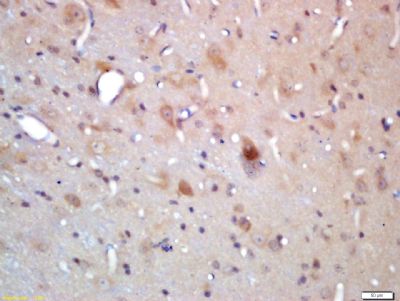产品货号 : mlR11447
英文名称 : CRY2
中文名称 : 隐花色素蛋白2抗体
别 名 : cry2; CRY2_HUMAN; cryptochrome 2 (photolyase like); Cryptochrome2; Cryptochrome 2; Cryptochrome-2; FLJ10332; growth inhibiting protein 37; HCRY2; KIAA0658; PHLL2; Photolyase like.
研究领域 : 细胞生物 神经生物学
抗体来源 : Rabbit
克隆类型 : Polyclonal
交叉反应 : Human, Mouse, Rat, Chicken, Dog, Pig, Cow, Horse, Sheep,
产品应用 : WB=1:500-2000 ELISA=1:500-1000 IHC-P=1:400-800 IHC-F=1:400-800 ICC=1:100-500 IF=1:100-500 (石蜡切片需做抗原修复)
not yet tested in other applications.
optimal dilutions/concentrations should be determined by the end user.
分 子 量 : 65kDa
细胞定位 : 细胞核 细胞浆
性 状 : Lyophilized or Liquid
浓 度 : 1mg/ml
免 疫 原 : KLH conjugated synthetic peptide derived from human Cryptochrome 2:241-340/593
亚 型 : IgG
纯化方法 : affinity purified by Protein A
储 存 液 : 0.01M TBS(pH7.4) with 1% BSA, 0.03% Proclin300 and 50% Glycerol.
保存条件 : Store at -20 °C for one year. Avoid repeated freeze/thaw cycles. The lyophilized antibody is stable at room temperature for at least one month and for greater than a year when kept at -20°C. When reconstituted in sterile pH 7.4 0.01M PBS or diluent of antibody the antibody is stable for at least two weeks at 2-4 °C.
PubMed : PubMed
产品介绍 : Circadian clocks are biological timepieces that regulate hormonal rhythms, sleep cycles and feeding behaviors. These rhythms are generated in the superchiasmatic nucleus (SCN), a cell-autonomous circadian oscillator located within the brain that is synchronized with the environment by light. A number of transcription factors, including Clock and BMAL1, are molecular components of the SCN that induce the expression of proteins involved in light/dark cycle entrainment, which include Per1 and Per2. Tim, for timeless, generates a negative feedback loop that regulates the activity of Clock by suppressing the expression of Clock target genes. Tim forms heterodimers with Per1 and Per2 that bind Clock and block the activation of Clock-BMAL1 dimers to repress Per gene expression. Additionally, the CRY proteins, which are cryptochrome photoreceptors for the circadian clock, function as light-independent inhibitors of the circadian clock. CRY1 and CRY2 negatively regulate SCN components by associating with the activators Clock-BMAL1, and also with the various feedback inhibitors Per1, Per2 and Tim.
Function:
Blue light-dependent regulator of the circadian feedback loop. Inhibits CLOCK NPAS2-ARNTL E box-mediated transcription. Acts, in conjunction with CRY2, in maintaining period length and circadian rhythmicity. Has no photolyase activity. Capable of translocating circadian clock core proteins such as PER proteins to the nucleus. May inhibit CLOCK NPAS2-ARNTL transcriptional activity through stabilizing the unphosphorylated form of ARNTL.
Subunit:
Component of the circadian core oscillator, which includes the CRY proteins, CLOCK or NPAS2, ARNTL or ARNTL2, CSNK1D and/or CSNK1E, TIMELESS, and the PER proteins. Interacts directly with PER1 and PER2 C-terminal domains. Interaction with PER2 inhibits its ubiquitination and vice versa. Interacts with NFIL3. Interacts with FBXL3.
Subcellular Location:
Cytoplasm. Nucleus. Translocated to the nucleus through interaction with other Clock proteins such as PER2 or ARNTL.
Tissue Specificity:
Expressed in all tissues examined including fetal brain, fibroblasts, heart, brain, placenta, lung, liver, skeletal muscle, kidney, pancreas, spleen, thymus, prostate, testis, ovary, small intestine, colon and leukocytes. Highest levels in heart and skeletal muscle.
Post-translational modifications:
Phosphorylation on Ser-266 by MAPK is important for the inhibition of CLOCK-ARNTL-mediated transcriptional activity. Phosphorylation by CSKNE requires interaction with PER1 or PER2.
Ubiquitinated by the SCF(FBXL3) and SCF(FBXL21) complex, leading to its degradation.
Similarity:
Belongs to the DNA photolyase class-1 family.
Contains 1 DNA photolyase domain.
SWISS:
Q49AN0
Gene ID:
1408
Important Note:
This product as supplied is intended for research use only, not for use in human, therapeutic or diagnostic applications.
产品图片












